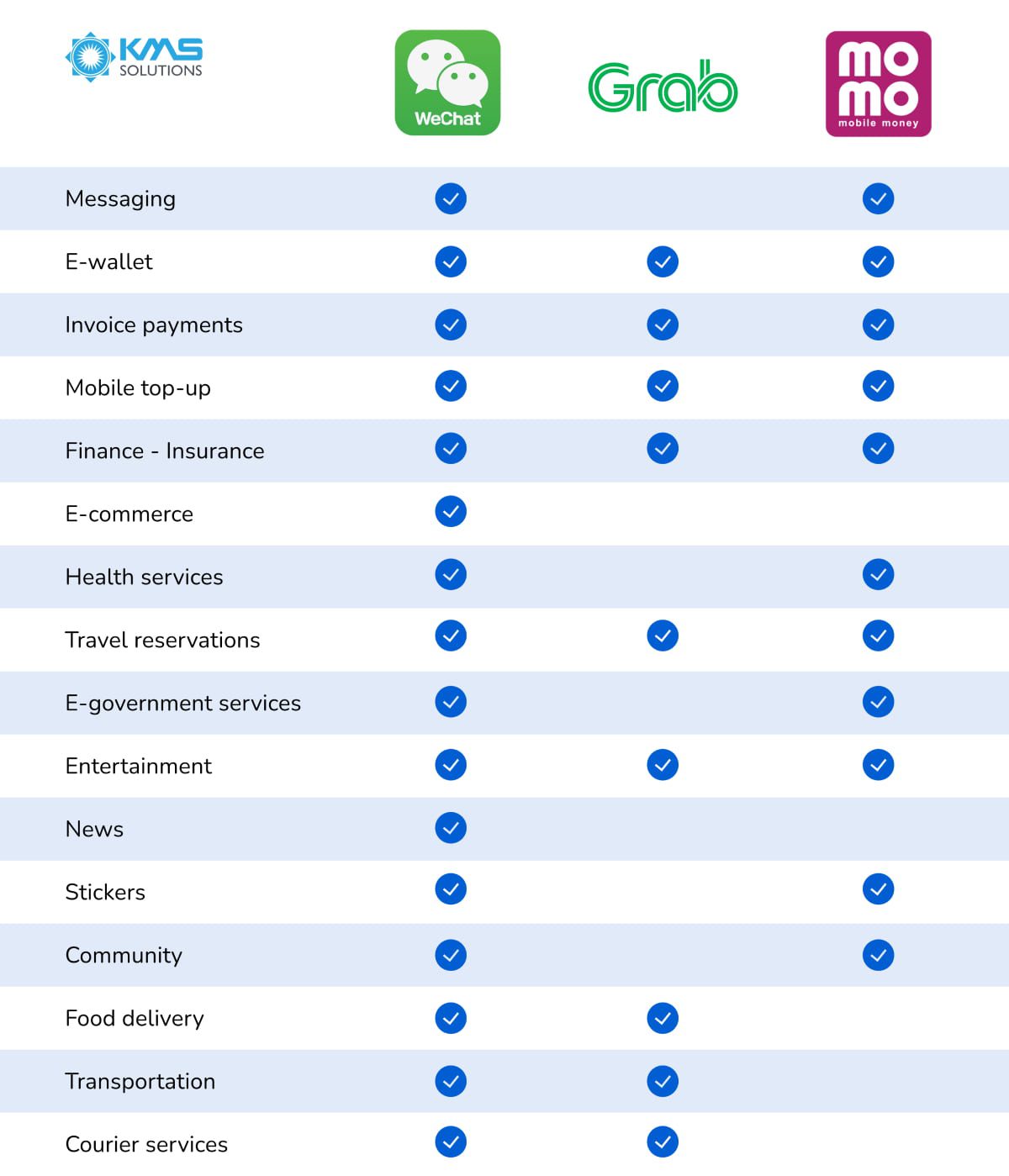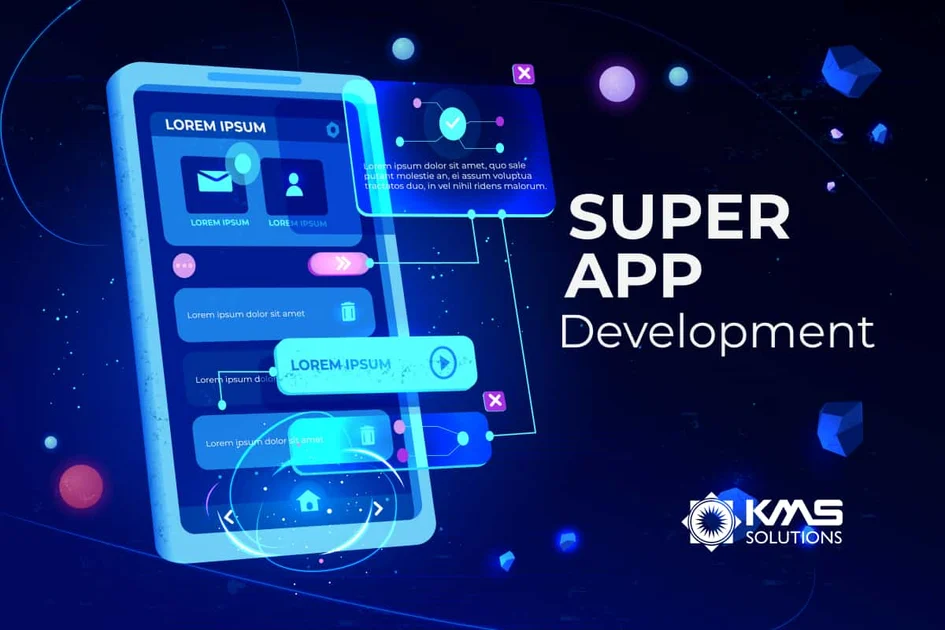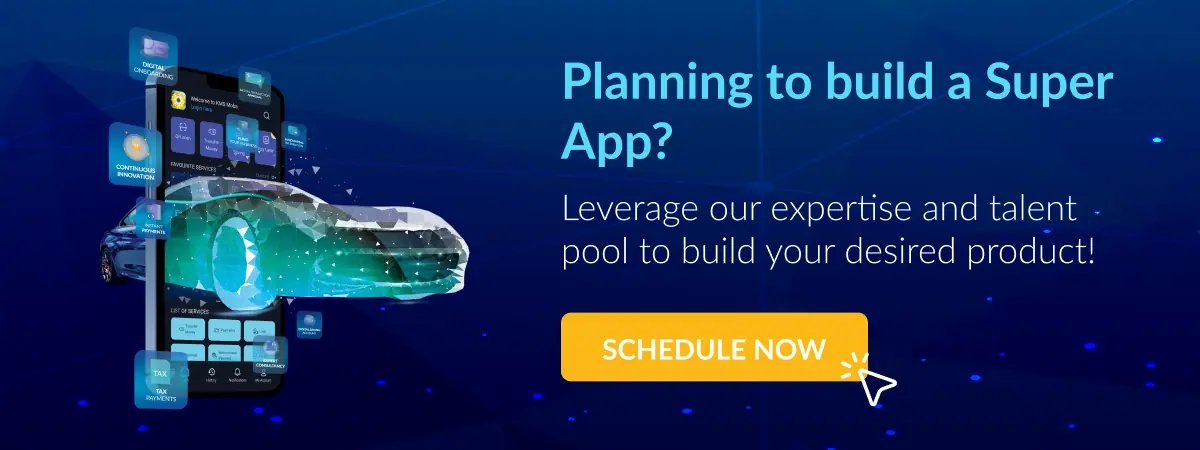Since demand for a single platform incorporating several services has increased remarkably in emerging regions, the Super App model is gaining momentum. Super App is a one-stop solution to meet all consumers’ needs and expectations. It not only provides users with a hyper convenient experience but also helps them clear the smartphone’s memory of digital junk.
In response to the booming on-demand market, there is no wonder that enterprises want to set their foot in this competition. If you’re planning to build one, this complete guide to developing the Super App is for you!
What to Consider during the Super App Development?
Developing the super app is more complicated than a simple one. Thus, to tackle such a project, businesses must be well-equipped with all the necessary resources and have the right strategy. Here are some key points to consider while building the super application:
- Start with a core product: major super apps often start with a single function and then expand their services after accumulating a large user base. Momo, after obtaining a substantial customer base with its e-wallet service, has launched additional financial functions into its ecosystem, such as buy now pay later, momo savings, communication, etc. Subsequently, the app gained more new users beyond the original ones.
- Concentrate on the seamless user experience: the super app should simplify all activities within the platform, e.g., allowing users to apply for promotions and make payments without having to leave the app. Creating innovative user-focused experiences is vital in today’s competitive digital-first world. Baidu – the “Google of China” – has lost its market shares to WeChat due to its inability to enable payment within the same platform.
- Have a robust supply-side economy: one determining factor for the success of some transport services such as Uber, GoJek, or Grab is that they used their stronghold in supplying transportation to offer extra services for users later.
- Develop collaborations and ecosystems with third parties: to support entire lifestyle journeys, the super app needs to create a comprehensive ecosystem of businesses, bringing together a vast diversity of suppliers. It’s worth remembering that one corporation cannot build products for various verticals outside their general bounds of expertise that provide users with the best values.
6 Key Steps to Develop a Super App
Prior to starting the development process, enterprises should conduct market research to determine target customers and understand their requirements and expectations. Once your buyer persona has been identified, you can build super apps upon those insights.

Step 1: Choose a Suitable Platform
Choosing between platforms to operate depends on your target audience. If your concentration is limited to a specific set of audiences, a single platform can be a better choice. However, if your reach is wide, you might have to go for separate categories of apps. There are three options to develop the super application:
- Native App: are designed for a single platform such as Android, iOS, or Windows. Each of them has a distinct programming language and development tool.
- Cross-Platform App (or Hybrid App): in this solution, the same codebase is used to develop for multiple platforms. Similar to how native apps are uploaded, you can publish these hybrid apps on app stores.
- Web App: here, a mobile-optimized website is constructed. These apps resemble native/hybrid apps in the interface, yet they operate in browsers like a normal website. Their UI/UX is inferior to those of native/cross-platform apps.
Besides, you may also choose among those options based on the available resources, your budget, and other factors.
Step 2: Prepare a Feature List
The super app development process relies significantly on the feature-set integration. These features should be based on major customer requirements, user-friendly but still unique enough to make the solution prominent. Here are some of the potential features that you can consider including in all kinds of super apps:
- Google / Social media integration: this feature enables customers to log in or make the signup effortlessly through their Google or Social media accounts (Facebook, Linkedin, Twitter).
- Multi-language support: if you’re planning to expand your super app to several regions and reach a larger audience group, allowing users to choose their preferred languages is worth considering.
- Payments system: including cashless payments, mobile payments, investment, QR code payments, etc. Super apps like Wechat and Momo also cooperated with banks to provide some basic banking and saving services to users.
- Schedule booking: this feature allows users to book the services they demand directly on one app without logging in on other sites.
Despite having some general features, super apps with different core products will provide separate lists of services. Thus, you should break down the use cases to scale outside the core functionality. By partnering or linking services with other third parties, you can expand current offerings more effectively. Although the original idea of Momo is the digital wallet, the app has collaborated with some service providers such as Beamin, 7-eleven, Ahamove, Gojek, etc. to grow its ecosystem.
Learn more: 8 widely-used super apps in Asia
Services offered by the most popular super-app worldwide

Step 3: Decide on Digital Business Model
Super app combines the functionalities of multiple standalone app uses, and each function has a different aim and business model. To generate profits from the app and maintain its system, you should then consider monetization strategies:
- Gratis: by offering products or services free of charge, you can achieve monetization more effortlessly once customers have become accustomed to the offerings. Free services often include messaging, money transferring, invoice payments, and online booking.
- Freemium: businesses may provide services with limited functionality available free of charge with the hopes that consumers would eventually upgrade to the premium version. Line – a messaging app from Japan – also provides freemium sticker packages and in-app games.
- Subscription: Instead of purchasing a product or service once, users can subscribe to a monthly or annual plan. Zalo, for example, has just introduced subscription fees for its messaging feature with many benefits, including extended contact lists and more searches.
- Advertising: you can offer some ad space in-app, generating money from audiences who see and click on them. News, food delivery, and e-commerce are services that often contain ads.
- Peer-to-peer (two-side marketplace): this is a decentralized platform where two parties participate in a transaction. Users can utilize the super app to buy or sell goods. However, they also need to pay commission fees, platform service fees, or delivery fees. This digital business model is suitable for services such as food delivery, courier services, ride-sharing, etc.
Step 4: Consider the Tech Stacks and the Development Team
Providing multiple functionalities within a single app requires sufficient top-notch technology as well as a skillful development team to ensure the platform runs effectively.
- A technology suite includes: HTML5, CSS, React Native, Flutter, Bootstrap, Fabric, Google (Cloud Messaging, Maps, Compute Engine), and so on.
- Programming & testing languages: Java, JavaScript, C#, Python, Ruby, PHP.
- Frameworks/ Tools for developing: Redux, ReactJs, SASS, Ruby on Rails.
- Frameworks/ Tools for testing: Katalon, Selenium, Appium.
- Other tools: email marketing, management tools, analytics, finance, and more.
Another determinant of the super app’s success is the development team. To handle this project effectively, you need to define the number of the workforce needed as well as their roles and responsibilities in each development phase. For instance, Revolut – one of the most well-known financial super apps, has separated its development teams for each mobile platform. Each platform has cross-functional teams that manage particular service features (payment, lifestyle, trading, etc.), and each team has approximately 60 software engineers using native technologies (Swift, Kotlin).
Moreover, as developing the super app will need a considerable amount of technical experts, outsourcing IT services can be a potential option. It’s essential to choose an experienced super app development company that helps you turn your ideas into practical products.
Step 5: Design, Develop and Test
Once you’ve determined your app’s objectives, target audience, business model, and features, the next step is planning the super app architecture. After settling on the app functionality, you should consider the customer journey, regarding how users will interact and the entire navigational flow of your app. Building a minimum viable product (MVP) can assist you in collecting customer feedback on the first product and incorporating it into subsequent versions.
The design phase includes considering user flow, sketching app wireframes, preparing prototypes, and building an app interface. Using wireframes, you basically have the mobile app’s skeleton and can visualize the app. When the wireframes are completed, then it is the responsibility of front-end and back-end developers to code and build the app. They must organize the technical side of the problem: how third-party programmers will deliver services inside the super app to optimize its work and minimize disruptions.
When it comes to the staging phase, QA specialists are in charge of testing functionality, interoperability, system integration, and more. Depending on the project’s requirements, you might choose between manual and automated testing. Moreover, you can also test the app with real users through a beta testing version to improve the app.
Step 6: Ensure Security and Constantly Update
As users are rightfully becoming more sensitive to privacy issues, providing a secure and safe app is key. Along with adding new products and features at a breakneck pace, Gojek also concentrates on providing a world-class security program for its users. By building a Security Pipeline, the app can solve digital issues such as Hardcoded credentials in code, Vulnerable Code dependency, Automated API whitelisting, etc.
After deploying the app, you also need to continuously upgrade it to catch up with the trends and meet customers’ changing requirements.
Tips to Build Super App Successfully
Creating a groundbreaking mobile application is not an easy feat. It should contain the critical set of services that are delivered to consumers through a mobile app and a robust technology platform to support those services. If you want to develop a successful super app or turn your existing app into one, consider the following advice:
- Personalization: everyone has their own favorite services. Users may leave your app if they can’t acquire the services they need with a single touch. Thus, you can consider showing personalized push notifications or offers to attract them.
- Informational security: the app must be transparent about the information it gathers from users; the data must be necessary for the app to perform its functions and must not be shared with any other parties.
- Dedicated customer service: regardless of how well the app is developed, it cannot receive positive reviews without good customer service. Especially for super apps that adopt a digital business model of P2P, they should pay more attention to customer support since they are the ones on the hook for the service fees.
- Minimalism: prevent overloading your super app with all kinds of services. Instead, you should only show the popular or recommended services on the homepage and hide the remains on other pages.
A super app is one of the simplest user acquisition and engagement platforms as it provides a more convenient experience when using an all-in-one app with all required services than switching between multiple apps. But don’t make your app unnecessarily complicated by adding features nobody uses, just focus on those that users really need.
At KMS Solutions, we have helped many companies successfully execute their vision and build high-quality apps and software that match the market standard.












